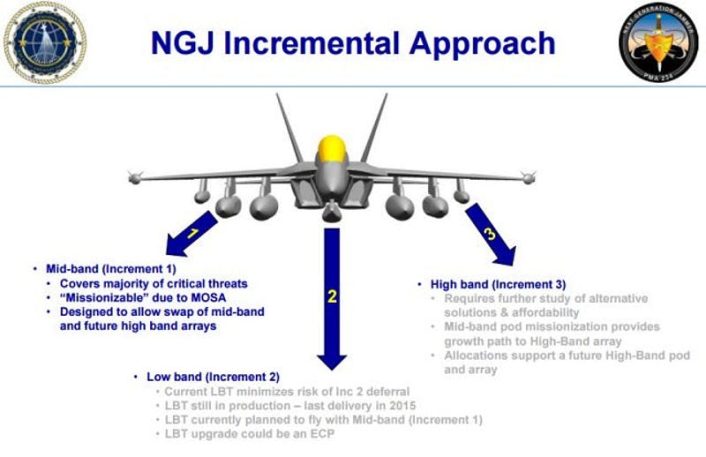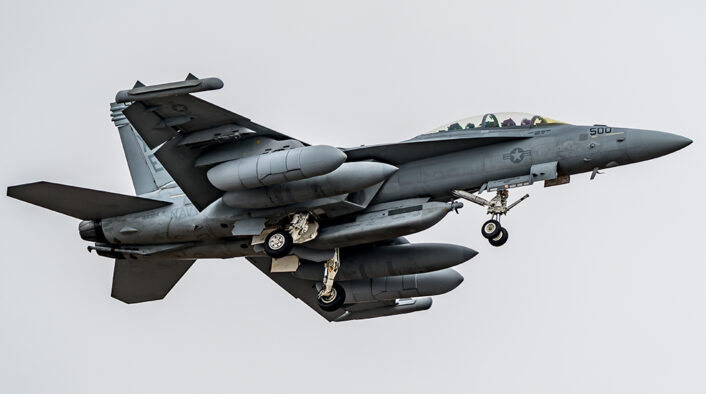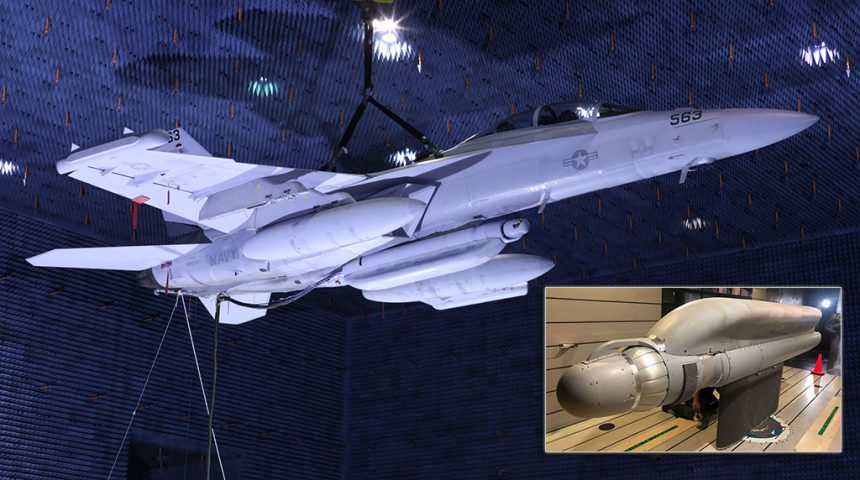L3Harris has recently shared some images and details about their submission for the NGJ-LB pod for the EA-18G Growler.
The NGJ (Next Generation Jammer) is a U.S. Navy program to augment, and ultimately replace the EA-18G Growler aircraft’s ageing ALQ-99 TJS (Tactical Jamming System) developed in the 1970s for the (retired) EA-6B Prowler.
Within the scope of the NGJ program, the Navy will replace the TJS pods operating in the 509 MHz to 18 GHz waveband, with three different pods, designated NGJ-MB (Mid Band), also known as Capability Block/Increment 1;, NGJ-LB (Low Band), aka Block/Increment 2; and NGJ-HB (High Band), aka Block/Increment 3; and directed specifically against the low- (100 MHz to 2 GHz waveband), mid- (2 GHz to 6 GHz), and high-band (6 GHz to 18 GHz) sections of the overall threat spectrum.
While NGJ-MB and -HB will replace the two ALQ-99 pods that Growlers carry under each wing, the NGJ-LB, will replace the low-band pod that the aircraft carry on the centerline store position under the fuselage.

The NGJ-LB will be extremely important to provide cover to stealth aircraft threatened by the emerging counter-stealth Low Band radars or to counter long-range weapons using low-frequency terminal guidance systems.
Raytheon was awarded the contracts for the NGJ-MB, also known as the AN/ALQ-249(V)1 pod, and two such pods were spotted being used together with the centerline ALQ-99 during Northern Edge 23-1 exercise in Alaska.

L3Harris Technologies won a four-year competition to field a NGJ-LB pod for the Boeing EA-18G Growler in December 2020. However, Northrop Grumman (whose submission we covered here) protested the award, alleging the Navy failed to consider the impact of a potential conflict of interest involving a Navy employee that developed specifications for the low-band system while simultaneously negotiating for employment with L3Harris during the solicitation.
Long story short, after years of protests and litigation, the U.S. Navy, along with L3Harris and Northrop Grumman, have agreed to a path forward to re-evaluate and ultimate re-award the Next Generation Jammer Low Band pod.
A contract is expected to be awarded in the next few months.
In the meanwhile, L3Harris has released some close up images of their submission for the much awaited NGJ-LB pod.
L3Harris released some close up shots of their NGJ-LB(Next Generation Jammer Low Band) Jammer pod.
Intresting looking pic.twitter.com/eYKOjaS2mw
— Fighterman_FFRC (@Fighterman_FFRC) August 29, 2023
Interestingly, the pod does not have the typical ram air turbine usually used by this kind of pod to generate the power needed to emit jamming signals and features an air intake duct similar to the one of the Sniper ATP (Advanced Targeting Pod).
Here are a few details about the pod the vendor provides through its official website:
Through high Equivalent, Isotropically Radiated Power (EIRP) and tailored waveforms, the NGJ-LB increases the number of simultaneous targets that aircrews can attack while reducing aircrew workload and cockpit distractions. The NGJ-LB’s advanced technology eliminates current system capability gaps while dramatically bolstering availability and sustainment.
NGJ-LB will be a high-powered and advanced AEA system. L3Harris’ jamming pod enables extended stand-off jamming, covers a broad spectrum of frequencies to service U.S. Department of Defense-wide EW demands, and will be more sustainable than the current system. The system will operate seamlessly with joint and allied forces and can incorporate new technologies to counter emerging threats.
The Navy expects contracted work to be completed within five years. NGJ-LB will address shortfalls in capability, availability and sustainment of the Navy’s existing AN/ALQ-99 Tactical Jamming System.









